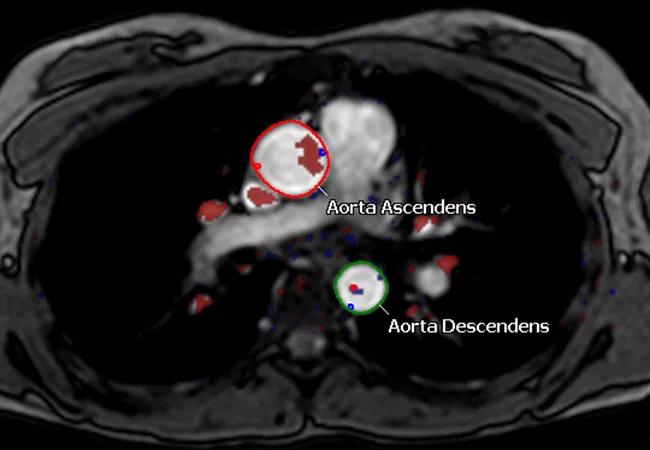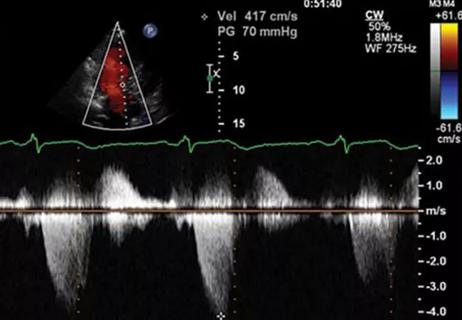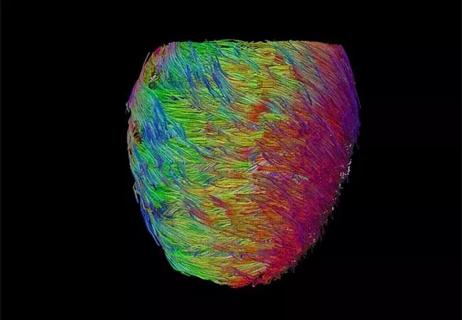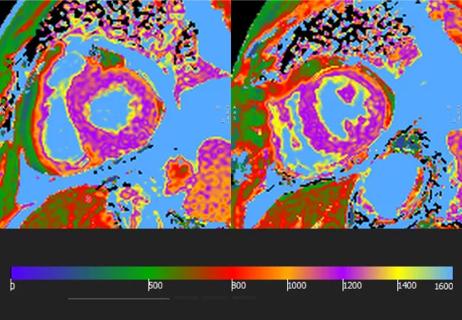Both sexes, but especially women, stand to benefit from adding it to echo

A new study identifying sex differences in left ventricular (LV) remodeling in response to significant aortic regurgitation (AR) points to the need for evaluation with cardiac magnetic resonance imaging (CMR) rather than sole reliance on echocardiography, particularly in women.
Cleveland Clinic is a non-profit academic medical center. Advertising on our site helps support our mission. We do not endorse non-Cleveland Clinic products or services. Policy
Among the study’s 243 patients (185 men and 58 women), 49% underwent surgery for severe chronic AR at Cleveland Clinic; in these surgical patients, CMR provided accurate and comprehensive quantitative assessment of LV remodeling. CMR also demonstrated that, compared with men, women demonstrated consistently smaller indexed LV volumes in response to chronic AR, in the setting of significantly larger LV basal diameters when indexed to height. In contrast, echocardiography significantly underestimated the degree of dilation compared with CMR, especially in women.
The study was published online in the Journal of Cardiovascular Magnetic Resonance.
Women with AR tend to be more symptomatic than men, but they are less likely to be referred for surgical intervention based on LV remodeling. Current guidelines for sending patients for aortic valve surgery in the setting of chronic AR are based on symptoms, AR severity and echocardiographic thresholds for LV dilation and reduced ejection fraction.
“However, echocardiographic assessment of LV size and severity of aortic regurgitation is subject to significant interobserver and interoperator variability, particularly in patients with significant LV dilation, thus limiting accuracy and reproducibility,” says Deborah Kwon, MD, Director of Cardiac MRI at Cleveland Clinic and corresponding author of the new study.
Although CMR is the gold standard imaging modality for LV size and function, current guidelines don’t include CMR thresholds for categorizing AR severity or degree of LV dilation to guide surgical referral for aortic valve intervention. “Based on our findings, CMR provides important evaluation of chronic AR, particularly with regard to the potential for determining optimal thresholds for surgical referral, which should include sex-specific LV remodeling thresholds,” Dr. Kwon notes.
The study included 243 patients with moderate to severe chronic AR who underwent CMR within 90 days of a qualifying echocardiogram at Cleveland Clinic from December 2005 to December 2019. Within this cohort, 119 subjects were subsequently referred for surgical intervention, with severe AR as the primary indication.
The CMR assessment revealed significant sex differences in LV remodeling. Specifically, women had (relative to men):
Comparative analysis of echocardiographic and CMR findings revealed that echocardiography became less accurate as the left ventricle enlarged for both men and women, but more so for women. In addition, LV length was greater and increased at a higher rate with increasing regurgitant fraction in men compared with women. Sphericity volume index was also higher in men than in women after adjustment for relative wall thickness (P = 0.033).
Dr. Kwon believes these data point to a need to derive sex-specific CMR standardized thresholds for LV volumes and LV diameters for surgical referral, as well as cutoff values for categorization of AR severity. In the meantime, she says, the findings have important implications for management of both men and women.
For men with AR who are asymptomatic, undergoing CMR is important for obtaining a more accurate assessment of ventricular dilation to ascertain the need for surgery. “Our study demonstrates that echocardiography increasingly underestimates LV dilation as LV dilation becomes more severe,” Dr. Kwon notes. “Therefore, decreasing accuracy in echocardiographic measurements in the patients who are in most need of accurate measurements to determine candidacy for surgery is a concerning finding.”
For women with AR, CMR is useful whether or not the patient is symptomatic. For women with symptoms and inconclusive severity of AR by echo, CMR offers the opportunity to more precisely measure the ventricle and quantify AR severity. “Blunted LV dilation in the setting of increasing aortic regurgitation severity and a conical pattern of remodeling may explain why women tend to be symptomatic at an earlier stage,” Dr. Kwon says. “However, it is not clear whether women should be referred to surgery earlier. More research and further studies are definitely needed to further elucidate the mechanism of blunted remodeling response in women. Additional studies are also needed to determine whether women may benefit from initiation of medical therapy to address sex-specific remodeling patterns.”
As a next step, Dr. Kwon hopes to expand this research into a multicenter study to validate the findings in diverse patient groups and hospital settings. She also wants to investigate the potential impact of CMR to improve outcomes in women.
“There is a deep need for sex-specific research to understand how we can optimize diagnostic criteria and personalize treatment for valvular heart disease, because women are clearly different from men,” Dr. Kwon observes. “One size does not fit all. The vast majority of research in cardiac disease has been conducted in men, and we have previously assumed that therapeutic strategies that are effective in men are equally effective in women. However, the data demonstrating sex differences in pathophysiology and outcomes have been growing. More dedicated research is needed to further understand these sex differences and how we can optimize treatment and outcomes for both men and women.”
“AR is the most difficult valve condition to manage, as clinical findings and even echo may provide conflicting estimates of severity and clinical impact,” says Brian Griffin, MD, Section Head of Cardiovascular Imaging at Cleveland Clinic. “CMR is a usual go-to technique to resolve diagnostic uncertainty. Past studies have suggested worse outcomes in AR in women, possibly due to using thresholds of intervention of LV size unadjusted for gender and body size. Dr. Kwon’s work in this study indicates that CMR is particularly helpful in distinguishing gender differences in LV remodeling in AR that not only are interesting scientifically but may allow a framework for optimizing the timing of intervention for AR in women.”

Technique may lay groundwork for personalized decision-making in procedural intervention

Gains are associated with clinical and biomarker benefits in obstructive HCM

Focus is on giving patients a better imaging experience while acquiring more data

Researchers urge adding evaluation of atria when assessing patients for cardiac amyloidosis

Systematic quantification and evaluation will shape surgical, transcatheter treatment of valve dysfunction

Study identifies imaging parameters for predicting mortality risk

Advancements are expanding applications and improving accuracy and patient experience

Cleveland Clinic series supports re-repair as a favored option regardless of failure timing